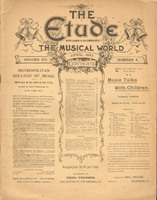Karolus Wahlstedt, of Hamburg, Germany, has the following to say in the Oesterreichische Musik und Theaterzeitung, on “Hearing Colors”: “It is an undisputed fact that many people associate tone with color. As is always the case, this sense of perception is more acute in some than in others. For instance, a lady of considerable musical attainment claims to see light orange whenever she hears music. Lombroso has written at length upon color in music, but with all his investigation did not come to any definite conclusion as to the cause thereof. My own observations are somewhat as follows:
“D major, military blue.
“E major, pure white.
“F major, light brown.
“G major, meadow green.
“A major, scarlet.
“B major, light blue.
“B flat major, orange.
“D flat major, deep black.
“E flat major, violet.
“F sharp major, old gold.
“A flat major, dark blue.
“C major has, however, never awakened, in me, any sense of color, and, therefore, I am unable to assign to it a specific character. To me it is the ‘musical maid of all work.’
“These colors are most perceptible when the music is rendered by wind instruments, or by a full orchestra; but the same effect is conceivable, although not nearly so distinct, when the piano is played in the middle register. When playing in the treble of that instrument all color-character is lost. A chromatic scale played rapidly, on the violin or clarionet, brings before my mind all colors of the rainbow.
“From the above table it is evident that certain tones are especially adapted for certain uses. For instance: I couple D major with chivalry and victorious rejoicing, as also A and B major (red and blue). With E, innocence and tenderness. G major is especially adapted to describe pastoral scenes; D flat major to express grief or funeral music, as is also A flat. The colors of these tones, deep black and dark blue, are, to me, most distinct in this connection. F sharp major has a rich golden color, and is, therefore, appropriate for parlor music. F, B, and E flat, the middle colors, are most adaptable for dance music. These are, on the whole, my ideas in this connection, which have been considered sound by many fine musicians to whom I have submitted them. Numerous examples could be cited from the works of the great masters, but that would lead us too far here. I only wish to mention that especially the symphonies of our tone-heroes, to which Brückner belongs, offer an almost unlimited field for convincing research in this direction, and every musician to whom this question is of interest can readily find examples therein.
“It is most difficult to explain this hearing of colors, and, as already stated, Lombroso does not come to any definite conclusion. My own idea is that tone and color has at some time been so closely allied that it left an indelible impression upon the mind’s eye, in consequence of which, whenever the same tone is heard again, the same color recurs to the mind, and thus to the living eye. As an example, I would mention the overture to Weber’s ‘Oberon.’ Note the martial character of the music,—it is genuine, victorious rejoicing. The impression of the overture upon me (although unconsciously), may have been such that for all time the tone of D major will bring to my mind the knights in military blue, and the same holds good in Chopin’s ‘Funeral March.’
“At any rate, the composer must, consciously or unconsciously, know what character or color to assign to the different tones, otherwise he will be incapable of producing anything characteristic. If a piece or song is transposed into another key from that in which it was originally written, it loses its innate character. As the painter distinguishes between his colors, so must the tone-painter distinguish between his colors or tones if he wishes to be original. F sharp major is not adapted to dance music, and A major, to my mind, is not especially apropos for a funeral march.”



